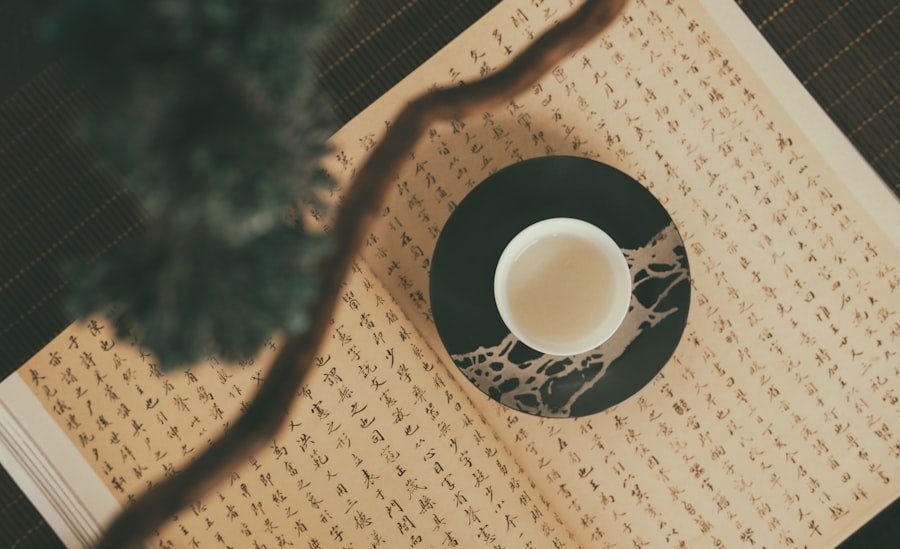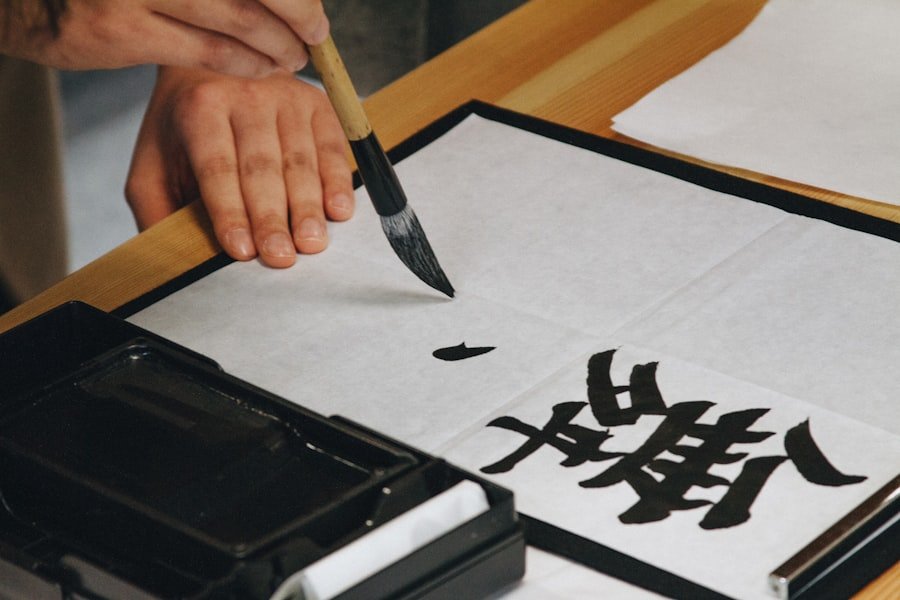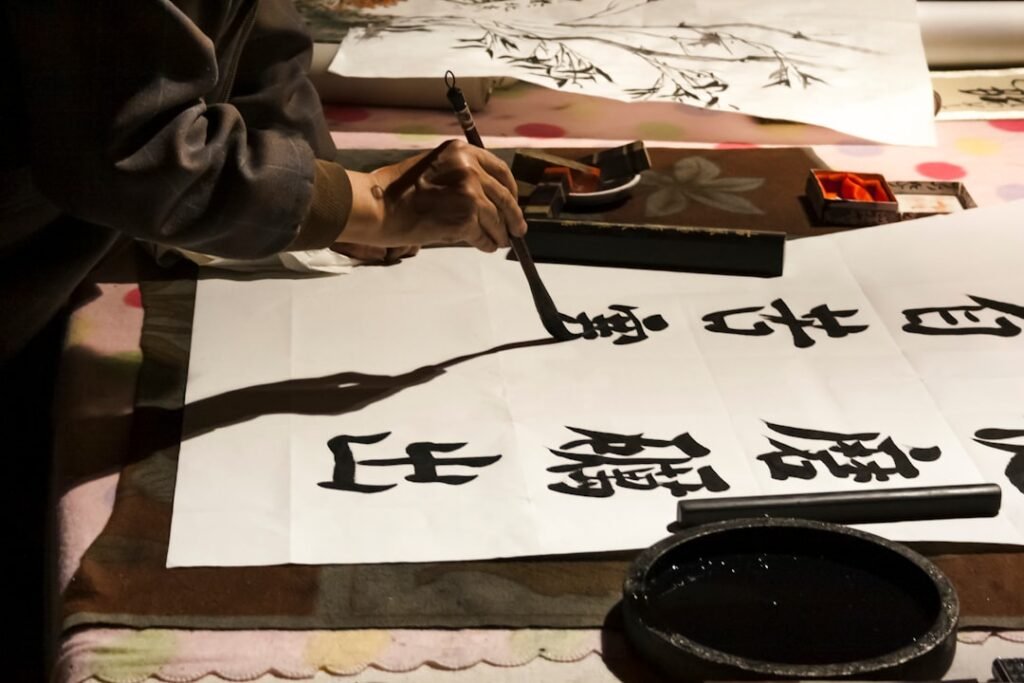Chinese calligraphy, an ancient art form that has been practised for thousands of years, is much more than just writing; it is a profound expression of culture, philosophy, and emotion. This intricate practice involves the careful manipulation of brush and ink to create characters that are not only legible but also aesthetically pleasing. Each stroke carries meaning, and the way it is executed can convey a range of sentiments, from joy to sorrow.
The beauty of Chinese calligraphy lies in its ability to blend artistry with linguistic expression, making it a unique form of communication that transcends mere words. At its core, Chinese calligraphy is steeped in tradition and history. It has evolved through various dynasties, each contributing its own style and techniques.
The art form is often associated with the principles of Confucianism, Taoism, and Buddhism, which emphasise harmony, balance, and the importance of self-cultivation. As practitioners engage with this art, they not only learn to appreciate the beauty of the characters but also delve into the philosophical underpinnings that have shaped Chinese culture for centuries. This makes Chinese calligraphy a rich and rewarding pursuit for anyone interested in exploring the depths of artistic expression and cultural heritage. Master the art of Chinese calligraphy. Enroll now at the LC Chinese School in Oslo.
Table of Contents
ToggleSummary
- Chinese calligraphy is a traditional art form that involves writing Chinese characters with a brush and ink, and it is highly regarded for its aesthetic and cultural significance.
- Daily practice of Chinese calligraphy can lead to improved concentration, mindfulness, and patience, making it a valuable tool for enhancing mental focus and clarity.
- Calligraphy requires a high level of concentration, as the artist must carefully control the brush strokes and maintain a steady hand to create beautiful and harmonious characters.
- By engaging in calligraphy practice, individuals can develop their ability to focus and concentrate, which can have a positive impact on other areas of their lives, such as work, study, and daily tasks.
- Incorporating calligraphy into a daily routine can help individuals cultivate mindfulness and improve their concentration, ultimately leading to a more balanced and focused mindset.
The Benefits of Daily Practice
Engaging in daily practice of Chinese calligraphy offers a multitude of benefits that extend beyond the mere act of writing. One of the most significant advantages is the enhancement of fine motor skills. As practitioners repeatedly execute strokes with precision, they develop greater control over their hand movements, which can translate into improved dexterity in other areas of life.
This fine motor development is particularly beneficial for children, as it lays a foundation for skills such as writing and drawing. Moreover, daily practice fosters a sense of discipline and commitment. The act of setting aside time each day to focus on calligraphy encourages individuals to cultivate a routine that prioritises creativity and self-expression.
This commitment can lead to a greater sense of accomplishment as practitioners witness their progress over time. Additionally, the repetitive nature of calligraphy can serve as a calming ritual, providing a moment of respite from the chaos of daily life. As individuals immerse themselves in the flow of ink on paper, they often find a sense of peace and clarity that can enhance their overall well-being.
The Link Between Calligraphy and Concentration

The intricate nature of Chinese calligraphy necessitates a high level of concentration. Each character comprises multiple strokes that must be executed with precision and care. This requirement for focus creates an environment where distractions are minimised, allowing practitioners to immerse themselves fully in the task at hand.
As individuals engage with the brush and ink, they are compelled to direct their attention solely to the creation of each character, fostering a deep sense of presence in the moment. Furthermore, the practice of calligraphy can serve as a powerful tool for enhancing concentration in other areas of life. The skills developed during calligraphy practice—such as attention to detail and sustained focus—can be transferred to various tasks, whether academic or professional.
As individuals learn to concentrate on the delicate movements required in calligraphy, they may find that their ability to focus on other activities improves as well. This interconnectedness highlights the profound impact that engaging in such an art form can have on cognitive abilities.
How Calligraphy Can Improve Focus
Calligraphy is not merely an artistic endeavour; it is also a mental exercise that sharpens focus. The process requires practitioners to be acutely aware of their movements and decisions as they create each stroke. This heightened awareness cultivates a sense of mindfulness that can significantly improve overall focus.
As individuals become more attuned to their actions during calligraphy practice, they develop an ability to concentrate on tasks outside of this art form. Moreover, the rhythmic nature of brush strokes can induce a meditative state that further enhances focus. As practitioners repeat strokes and characters, they often enter a flow state where distractions fade away, allowing them to concentrate deeply on their work.
This meditative quality not only improves focus during calligraphy but can also extend to other aspects of life, enabling individuals to approach challenges with greater clarity and determination.
The Importance of Mindfulness in Calligraphy
Mindfulness is an essential component of Chinese calligraphy practice. The act of writing becomes a form of meditation, where practitioners are encouraged to be fully present in the moment. This mindfulness allows individuals to connect with their inner thoughts and emotions as they create each character.
By focusing on the brush’s movement and the ink’s flow, practitioners cultivate a deeper awareness of their surroundings and themselves. Incorporating mindfulness into calligraphy practice can lead to profound insights and personal growth. As individuals engage with their emotions through the strokes they create, they may discover new perspectives on their experiences.
This reflective aspect of calligraphy not only enhances artistic expression but also promotes emotional well-being. By embracing mindfulness in their practice, individuals can transform calligraphy into a powerful tool for self-discovery and healing.
Techniques for Developing Concentration Through Calligraphy

To maximise the benefits of concentration during calligraphy practice, several techniques can be employed. One effective method is to establish a dedicated space for practice that is free from distractions. Creating an environment conducive to focus allows practitioners to immerse themselves fully in their work without interruptions from external stimuli.
This space should be equipped with all necessary materials—brushes, ink, paper—so that individuals can engage in their practice seamlessly. Another technique involves setting specific goals for each practice session. Whether it is mastering a particular character or refining stroke techniques, having clear objectives helps maintain focus throughout the session.
Practitioners can track their progress over time, which not only reinforces their commitment but also provides motivation to continue improving. Additionally, incorporating short breaks during practice can prevent mental fatigue and enhance overall concentration by allowing individuals to recharge before returning to their work.
The Role of Patience in Calligraphy Practice
Patience is a virtue that is deeply intertwined with the practice of Chinese calligraphy. Mastering this art form requires time and dedication; it is not something that can be rushed or achieved overnight. Each character demands careful attention and repeated effort to perfect its execution.
As practitioners navigate this journey, they learn to embrace patience as an essential component of their growth. The cultivation of patience through calligraphy extends beyond the art itself; it influences various aspects of life. As individuals learn to appreciate the gradual process of improvement in their calligraphy skills, they may find themselves more patient in other pursuits as well.
This newfound patience can lead to greater resilience when faced with challenges, fostering a mindset that values persistence and dedication over immediate results.
Using Calligraphy as a Meditation Tool
Calligraphy serves as an excellent meditation tool due to its rhythmic and repetitive nature. The act of creating characters becomes a form of moving meditation, where practitioners can lose themselves in the flow of ink on paper. This meditative quality allows individuals to quiet their minds and focus solely on the present moment, providing a respite from the stresses of daily life.
Incorporating calligraphy into meditation practices can enhance overall well-being by promoting relaxation and reducing anxiety. As individuals engage with their breath while writing, they create a harmonious connection between mind and body. This synergy fosters a sense of calm that can carry over into other areas of life, enabling individuals to approach challenges with clarity and composure.
Incorporating Calligraphy into Daily Routine for Improved Concentration
Integrating calligraphy into one’s daily routine can yield significant improvements in concentration over time. Setting aside dedicated time each day for practice allows individuals to establish a consistent habit that prioritises focus and creativity. Whether it is early in the morning or late at night, finding a time that works best for personal schedules ensures that calligraphy becomes an integral part of daily life.
Additionally, incorporating short sessions throughout the day can provide moments of mindfulness amidst busy schedules. Even just ten minutes spent practising strokes or characters can serve as a refreshing break from routine tasks, allowing individuals to return to their responsibilities with renewed focus and energy. By weaving calligraphy into daily life, practitioners can cultivate a deeper connection with themselves while enhancing their ability to concentrate.
Tips for Maintaining Focus During Calligraphy Practice
Maintaining focus during calligraphy practice can sometimes be challenging; however, several strategies can help enhance concentration. Firstly, minimising distractions is crucial—turning off electronic devices or finding a quiet space can create an environment conducive to focus. Practitioners should also consider using calming music or ambient sounds to enhance their experience without overwhelming their senses.
Another effective tip is to engage in deep breathing exercises before beginning practice. Taking a few moments to centre oneself through mindful breathing can clear the mind and prepare individuals for focused work ahead. Additionally, setting realistic expectations for each session allows practitioners to approach their work with a sense of ease rather than pressure, fostering an environment where creativity can flourish.
Harnessing the Power of Calligraphy for Improved Concentration
In conclusion, Chinese calligraphy offers a unique opportunity for individuals seeking to enhance their concentration while engaging in a beautiful art form steeped in tradition and culture. Through daily practice, practitioners develop fine motor skills, discipline, and mindfulness—all essential components for improving focus in various aspects of life. The meditative qualities inherent in calligraphy allow individuals to connect with themselves on a deeper level while cultivating patience and resilience.
For those interested in exploring this enriching art form further, the LC Chinese School in Oslo offers exceptional Chinese calligraphy courses designed for all skill levels. These courses provide an excellent platform for individuals to learn from experienced instructors while immersing themselves in the rich history and techniques associated with Chinese calligraphy. By participating in these classes, students not only refine their artistic abilities but also harness the power of calligraphy as a tool for improved concentration and personal growth.
Embrace this opportunity at LC Chinese School and discover how the art of calligraphy can transform your approach to focus and creativity.
Master the art of Chinese calligraphy. Enroll now at the LC Chinese School in Oslo.







